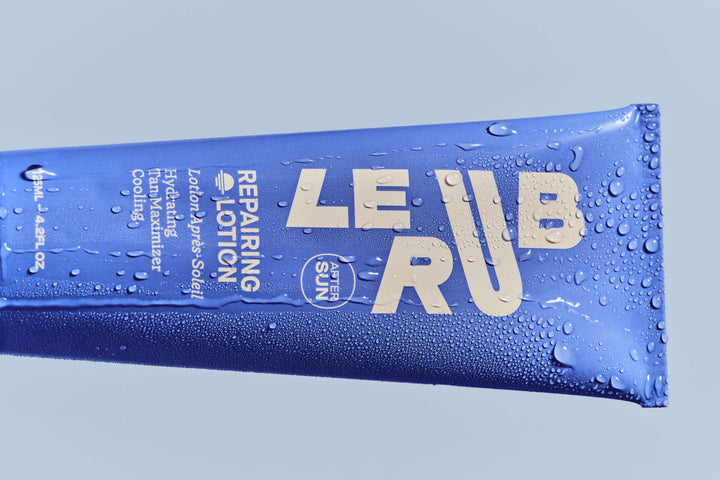Not all sunscreens are created equal.
While chemical sunscreens work by absorbing UV rays, mineral sunscreens, also known as physical sunscreens, provide a protective barrier that reflects these rays away from your skin. You might be aware that mineral sunscreens are often touted as a better choice for environmental health. Many enthusiasts advocate for these benefits at the beach and beyond. However, it's important to note that not all mineral sunscreens are perfect—some may leave a chalky sheen, among other concerns.
Le Rub believes knowledge is power, which enables us to make positive choices for our skin, health and planet. We've taken a unique approach to formulate our mineral sunscreens, ensuring they stand out in both efficacy and environmental friendliness. Different in a dazzling way. We considered every grumble aimed at traditional mineral sunscreen, and came up with the perfect formulas for everybody and the ecosystem.
Reef-Safe Ingredients Only
Le Rub uses non-nanotized zinc oxide only, which is the most coral-friendly active sunscreen ingredient available. The only two “reef-safe” active ingredients approved by the F.D.A. are “non-nanotized” zinc oxide or titanium dioxide. That means non-nano particles – which are 100, nanometer in diameter, or more. A lot of mineral sunscreens contain nano particles, which are less than 100 nanometers. These can slip into our skin, bloodstream and seas, to be ingested by aquatic wildlife. Non-nano zinc oxide has never been found to enter the bloodstream, and so has never been harmful for our health.
What’s Else Is Great About Non-Nano Zinc Oxide?
Non-nano zinc oxide sits on the skin’s surface, and acts as a barrier between you and the sun’s ultraviolet rays. Unlike a lot of synthetic ingredients and some chemical filters, non-nano zinc-oxide is suitable for those with sensitive skin or skin conditions such as acne, rosacea or eczema. All Le Rub formulas have been dermatologically - and flawlessly – approved on all skin types, and all skin tones.
Why We Chose to go Mineral over Chemical
You might wonder, have chemical sunscreens caused any harm? While they are effective, they come with complexities worth noting. Beginning with basics, chemical sunscreens need to bind with the skin to be effective, requiring application 20 to 30 minutes before sun exposure — a detail that's easy to overlook in our rush to enjoy the sun.
While chemical sunscreens absorb UV rays to protect us, the downside is that some of their ingredients can penetrate the skin and enter the bloodstream. This raises concerns, especially since some ingredients used for broad-spectrum UV protection are now restricted or banned in several regions due to environmental toxicity.. Moreover, the inclusion of preservatives, dyes, and synthetic fragrances can irritate the skin and affect marine ecosystems when they wash off.
The Environmental Effect of Chemical Sunscreen
Indeed, every spritz of sunscreen not only protects us but also leaves residues that can impact the coastal and marine environments. Recent studies suggest that certain chemical filters are hormone disruptors and pose a threat to marine life and corals. Ingredients have been found to kill developing coral, and bleach (or genetically damage) existing coral. Hawaii and Key West Florida (areas without a high turnover of water) have banned the ingredients octinoxate and oxybenzone, since 2021. Palau, in the Pacific, forbids banned ‘reef-toxic’ sunscreens containing one of any ten prohibited ingredients, and parts of Mexico require ‘reef-safe’ sunscreen too. However, let's not dismiss all chemical sunscreens. With rapid advancements in science, there's potential for discovering a chemical filter that offers similar benefits to our cherished zinc oxide. Rest assured, if such a breakthrough occurs, you'll probably find it here too.
Why Not All Mineral Sunscreens?
Unfortunately, not all mineral sunscreens are reef-safe. Some sun-screening formulas now combine zinc oxide with titanium dioxide and chemical filters. These chemical filters can irritate acne-prone or sensitive skin. We aim to do things differently. Every Le Rub product is plumped with premium skin-replenishing ingredients. All of our high-quality ingredients are non-irritating and designed for daily wear. And a reminder, non-nano zinc oxide has never been found to enter the bloodstream.
The Mask
What about that uncomfortable and infamous layer of white cast caused by mineral sunscreens? Le Rub uses high quality zinc dispersed alongside other premium ingredients resulting in our silky-smooth formulas. So no sticky feel or white cast. Just powerful and invisible sunscreen.
The Vitamin D Dilemma
By blocking UV rays, sunscreen also blocks our road to the bone-strengthening vitamin D. Le Rub’s Everyday Sunscreen stimulates vitamin D production in the body by including Grape seed ferment extract. It’s a fat-soluble vitamin with antioxidant and skin-soothing benefits for the skin. Clinical tests have shown that this wonder ingredient stimulates the Vitamin D receptor (VDR), allowing the body to respond to vitamin D.
Click here to find out more about why Le Rub uses non-nano zinc oxide only.














